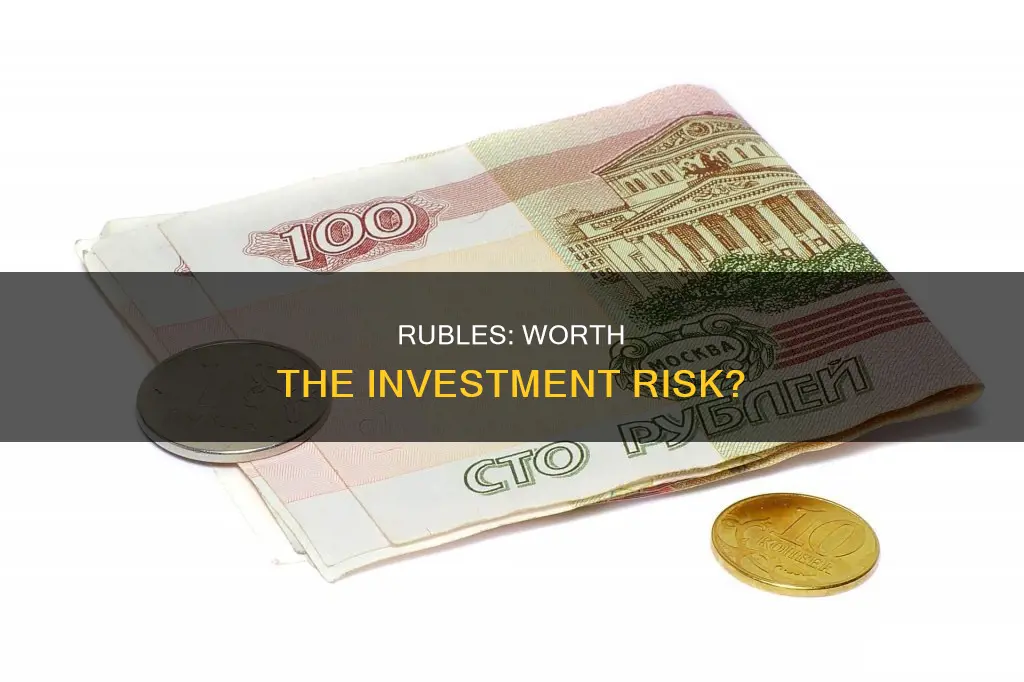
Investing in the Russian Ruble is a risky prospect. The Russian economy is in tatters, and the country is facing its deepest recession since the 1990s. The rebound of the ruble and stock market moves shouldn't be interpreted as a sign of Russia's economic recovery. The ruble's recovery to pre-war levels is largely due to the dramatic steps taken by Russia's central bank, such as more than doubling interest rates to 20% and banning Russian brokers from selling securities held by foreigners. With sanctions still in place and the threat of further restrictions, investing in rubles is a gamble that could pay off significantly or result in substantial losses.
| Characteristics | Values |
|---|---|
| Current status of the Russian Ruble | The Russian Ruble has made a full recovery and is trading at pre-war levels. |
| How has Russia propped up the Ruble? | The central bank has more than doubled interest rates to 20%, encouraging Russian savers to keep their money in the local currency. Exporters have been ordered to swap 80% of their foreign currency revenue for rubles. Russian brokers have been banned from selling securities held by foreigners. Residents are not allowed to make bank transfers outside Russia. Russia has threatened to demand payment for natural gas in rubles, not euros or dollars. |
| What is the predicted outcome of the above measures? | The rebound of the ruble shouldn't be taken as a signal that Russia's economy is recovering. The country is facing its deepest recession since the 1990s, and the economy will shrink by a fifth this year. When the restrictions are lifted, demand for the ruble will drop, and its value will slide. |
What You'll Learn

The impact of sanctions on the Russian economy
The sanctions imposed on Russia by the US and its allies in response to the invasion of Ukraine have had a significant impact on the Russian economy. The measures included restrictions on Russian banks' access to the US and European financial systems, limits on tech exports to Russia, and sanctions targeting Russian oligarchs and businesses. These sanctions caused a sharp decline in the value of the ruble and led to panic buying among Russians as they felt the impact of the sanctions.
To mitigate the effects of the sanctions, the Russian central bank implemented policies to prevent investors and companies from selling the ruble and took steps to artificially create demand for the currency. These measures included raising interest rates to 20%, ordering exporters to convert 80% of their foreign currency revenues to rubles, and restricting residents from making bank transfers outside of Russia. While these interventions helped stabilize the ruble and created a buffer against the initial economic shock, they are not expected to be effective in the long run.
The sanctions have isolated Russia from key imports, including high-tech products such as microchips, and even everyday items such as buttons for the garment industry. This has disrupted Russia's manufacturing sector and will make it more difficult for the country to produce goods, such as advanced weaponry, cars, and food. The sanctions have also restricted Russia's ability to export oil and gas, which are crucial sources of revenue for the country.
The impact of the sanctions on Russia's GDP is significant. By early 2023, Russia's real GDP was estimated to be 7-10% below what it would have been without the sanctions. This reduction in GDP growth is expected to continue through 2023 and into early 2024. The economic prospects for Russia depend heavily on what happens to its oil and gas exports and its ability to find new markets and suppliers.
The sanctions have also contributed to a brain drain, with skilled Russians, particularly in the tech sector, leaving the country. This will have long-term consequences for Russia's economy. Additionally, the sanctions have disrupted Russia's supply chains, making it more challenging to obtain spare parts and maintain infrastructure.
Overall, the sanctions have had a profound impact on the Russian economy, causing a deep recession and reducing the country's ability to finance its war efforts. However, it is important to note that the effectiveness of sanctions may wane over time as Russia finds workarounds and develops alternative trading patterns.
Wealth: Security, Freedom, and Legacy
You may want to see also

The central bank's intervention in the market
The Russian central bank has taken several measures to intervene in the market and prop up the rouble. Firstly, it has more than doubled interest rates to 20%, encouraging Russian savers to keep their money in local currency. Secondly, exporters have been mandated to exchange 80% of their foreign currency earnings for rubles instead of retaining them in stronger currencies like the US dollar or euro. Thirdly, Russian brokers have been prohibited from selling securities held by foreigners, and residents are banned from transferring money out of the country. Russia has also threatened to demand payment for natural gas in rubles, putting further pressure on European energy supplies.
These interventions have artificially inflated demand for the rouble, and once the restrictions are lifted, the currency's value is expected to slide, possibly dramatically. The central bank's actions are aimed at stabilising the financial market and preventing a repeat of the market collapse that occurred when Russia invaded Ukraine in 2022. The Moscow stock exchange fell 30% after reopening, and the rouble plunged to an all-time low of 89.60 against the dollar. The central bank purchased millions of roubles to prevent a further collapse and put a floor under the currency.
To support Russian commercial banks affected by falling share prices and Western sanctions, the central bank increased the daily amount of roubles it would swap for dollars from $3 billion to $5 billion. This allowed commercial banks to replenish their dollar stocks and repay foreign debts. The Bank of Russia also expanded the list of securities it accepts as collateral for providing liquidity.
The Russian central bank's foreign exchange interventions are aimed at managing the country's foreign exchange reserves and preventing excessive volatility in the rouble market. With Russia's economy facing significant challenges, these interventions are an attempt to stabilise the currency and prevent a financial crisis. However, the long-term effectiveness of these measures remains uncertain, and the country's economic outlook is still precarious.
SPACs: The New Investment Craze
You may want to see also

The effect of the Russia-Ukraine conflict on the rouble
The Russia-Ukraine conflict has had a significant negative impact on the Russian rouble. On the eve of the invasion, the rouble was trading at a rate of 81 to the dollar, but by early March, it had fallen to 150. The conflict has caused economic turmoil in Russia, leading to sanctions that disrupted trade flows and targeted the country's energy exports. As a result, the rouble lost more than half of its value, and Russia's central bank implemented stringent capital restrictions to maintain its value and avoid a currency crisis.
To boost the rouble, Russia's central bank more than doubled interest rates to 20%, encouraging Russian savers to keep their money in the local currency. They also banned Russian brokers from selling securities held by foreigners and restricted residents from making bank transfers outside the country. These measures artificially manufactured demand for the rouble, but they also restricted the flow of capital and created a perception that Russia was "uninvestable for foreign investors".
The conflict has also led to a sharp increase in oil and gas prices, which initially appeared to benefit the rouble due to Russia's position as a major exporter. However, the overall impact of the conflict and sanctions has been detrimental to the rouble's value. The currency has experienced a loss in value due to geopolitical uncertainty, and Russia has attempted to enhance its currency independence by denominating transactions in non-Western currencies.
The sanctions imposed on Russia cut off many Russian banks from the global interbank payment system and restricted Western banks from doing business with them. This further isolated Russia from international financial markets and made it more difficult to finance the conflict. In response, Russia threatened to demand payment for natural gas in roubles instead of euros or dollars.
While the rouble has recovered to pre-war levels as of April 2024, this rebound should not be interpreted as a signal that Russia's economy is improving. The country faces its deepest recession since the 1990s, and once the restrictions are lifted, the demand for the rouble is expected to drop, leading to a potential dramatic slide in its value.
Apple: Invest Now or Miss Out?
You may want to see also

The role of exporters in stabilising the rouble
The Russian government and the central bank have put pressure on large state-owned exporters to sell dollars and foreign currency revenues to stop further steep losses for the local currency and stabilise the rouble. This move comes after the rouble plunged to an all-time low in mid-December due to lower oil prices and Western sanctions, which make it almost impossible for Russian firms to borrow from the West.
In August 2023, the rouble strengthened to around 93 against the dollar after Russia decided against capital controls and opted for an informal agreement with exporters to help stabilise the currency. This decision came after a meeting between President Vladimir Putin, central bank governor Elvira Nabiullina, and Finance Minister Anton Siluanov.
Guidelines for large exporters are being prepared on an individual company basis and will go beyond mandating the sale of foreign proceeds to include hard-currency transfers such as dividend payments and loans. This is a softer version of restrictions on capital flows, as President Vladimir Putin has repeatedly promised not to reintroduce capital controls.
In 2022, exporters were ordered to swap 80% of their foreign currency revenues for rubles rather than holding on to US dollars or euros. This, along with other measures, allowed Moscow to artificially manufacture demand for the ruble. However, when the restrictions are lifted, demand for the ruble will drop, and its value will slide, possibly dramatically.
Investing: How to Choose Wisely
You may want to see also

The future of the Russian stock market
The Russian stock market is facing an extremely challenging environment, with the country's economy in a precarious situation due to international isolation and the impact of sanctions. The Moscow Exchange (MOEX) is Russia's largest public trading market for various financial products, and it has been a key target of sanctions, aiming to restrict Russia's ability to profit from its war efforts.
When Russia invaded Ukraine, its stock market index lost a third of its value, and the ruble crashed. The Moscow Exchange was closed for a month, and when it reopened, only 33 stocks were allowed to trade under heavy restrictions. Foreign investors were banned from selling their holdings, and short-selling was prohibited. The Russian government pledged to spend billions of dollars to support the market by buying shares.
The rebound of the Russian ruble and the temporary recovery of the stock market should not be interpreted as signs of Russia's economic recovery. The country is facing its deepest recession since the 1990s, and its economy is expected to shrink significantly. The measures taken by the Russian government to prop up the ruble and the stock market are artificial and unsustainable in the long run. Once the restrictions are lifted, demand for the ruble will likely drop, and its value will decline.
In conclusion, investing in the Russian stock market or the ruble at this time carries considerable risks. The country's economic outlook is bleak, and the current stability of its financial markets is largely artificial and unsustainable. Investors should carefully consider these factors before making any investment decisions regarding Russia.
Smart Ways to Invest Your $50
You may want to see also
Frequently asked questions
The Russian Ruble has been volatile due to the Russia-Ukraine conflict and subsequent sanctions imposed by the West. While the Ruble has rebounded to pre-war levels, this is largely due to artificial demand manufactured by the Russian government. For example, the central bank has more than doubled interest rates to 20%, encouraging Russian savers to keep their money in local currency. There are also restrictions in place on investors, including a ban on short selling. It is recommended to wait until these restrictions are lifted to assess the true value of the Ruble.
Two key factors supporting the Russian Ruble are Russia's switch to rubles for gas export payments and the mandate for exporting firms to convert 80% of their foreign currency earnings into rubles. These factors have contributed to the increased demand for the currency.
The Russian economy is facing significant challenges due to the sanctions and the country is expected to enter its deepest recession since the 1990s. There is also a risk that more sanctions will be imposed, further impacting the economy and the value of the Ruble. Investing in Russian Rubles at this time could be risky due to the economic and political uncertainties.
Yes, there are other investment options available that may offer more stability and potentially higher returns. Diversifying your investments across different currencies, asset classes, and geographic regions is generally considered a prudent strategy to manage risk and maximize returns.







